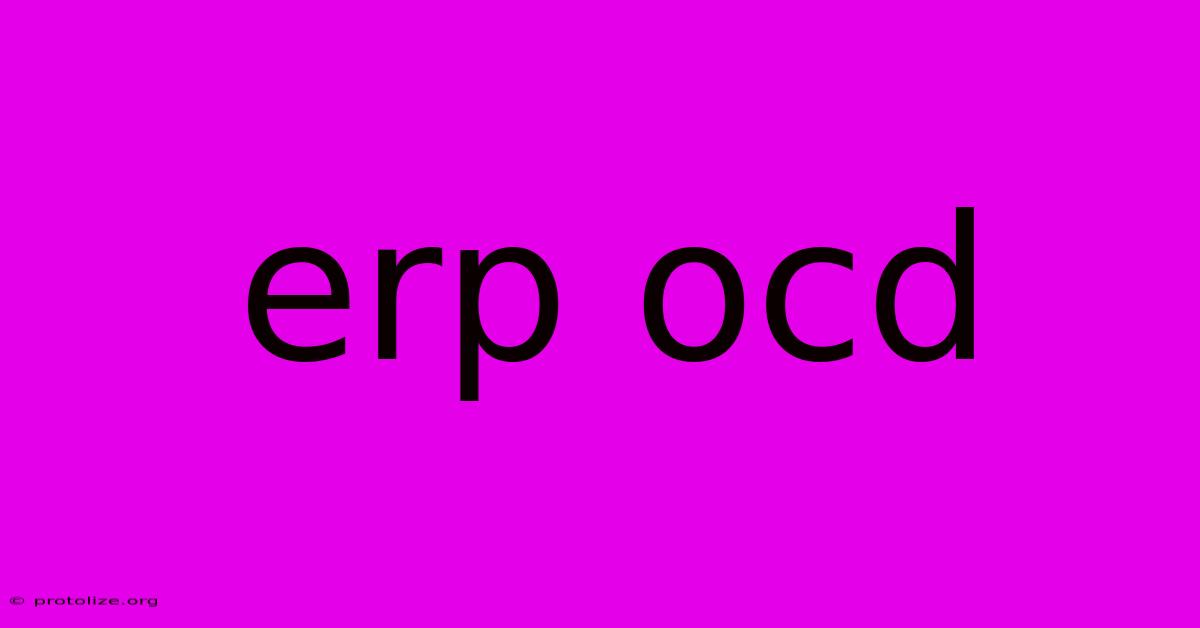Erp Ocd

Discover more detailed and exciting information on our website. Click the link below to start your adventure: Visit Best Website mr.cleine.com. Don't miss out!
Table of Contents
ERP OCD: Understanding and Managing the Cycle of Obsessions and Rituals
ERP OCD, or Exposure and Response Prevention for Obsessive-Compulsive Disorder, isn't a type of OCD itself, but rather a highly effective treatment for it. It targets the core of OCD: the relentless cycle of obsessions and compulsions. Understanding this cycle is crucial to understanding why ERP is so beneficial. This article will delve into the nature of ERP OCD treatment, exploring its mechanisms, benefits, and potential challenges.
What is OCD and the Obsession-Compulsion Cycle?
Obsessive-Compulsive Disorder (OCD) is a mental health condition characterized by intrusive, unwanted thoughts (obsessions) that cause significant anxiety. Individuals with OCD often engage in repetitive behaviors or mental acts (compulsions) to neutralize or reduce the anxiety triggered by these obsessions. This creates a vicious cycle:
- Obsession: An unwanted thought, image, or urge that causes distress and anxiety. Examples include fear of contamination, doubts about actions, or intrusive violent thoughts.
- Anxiety: The intense discomfort and worry generated by the obsession.
- Compulsion: A repetitive behavior or mental act performed to reduce anxiety. This could involve excessive handwashing, checking, counting, or mental rituals like praying or repeating phrases.
- Temporary Relief: The compulsion temporarily reduces anxiety, reinforcing the behavior.
- Return of Obsessions: The relief is temporary, and obsessions eventually return, restarting the cycle.
This cycle can be incredibly debilitating, impacting daily life, relationships, and overall well-being.
How ERP OCD Therapy Works
ERP therapy directly confronts this cycle. Instead of avoiding triggers or engaging in compulsions, ERP involves:
- Exposure: Gradually exposing oneself to feared situations or thoughts that trigger obsessions. This is done in a controlled and structured manner, starting with less anxiety-provoking situations and gradually increasing the intensity.
- Response Prevention: Resisting the urge to engage in compulsive behaviors. This is a crucial element, as it prevents the reinforcement of the compulsion-anxiety reduction cycle.
The goal of ERP is not to eliminate obsessions entirely (which is often unrealistic), but to significantly reduce their power and the need for compulsions. Through repeated exposure and response prevention, individuals learn that their feared outcomes are unlikely to occur and that anxiety naturally decreases over time without the need for compulsions.
Types of Exposures in ERP OCD Treatment
ERP utilizes various exposure techniques tailored to the individual's specific obsessions:
- In vivo exposure: Direct exposure to real-life situations or objects that trigger anxiety. For example, someone with contamination OCD might touch a doorknob without washing their hands afterward.
- Imaginal exposure: Imagining feared scenarios or thoughts. This is particularly useful for obsessions that are difficult to recreate in real life.
- Interoceptive exposure: Inducing physical sensations that trigger anxiety, such as rapid heart rate or dizziness. This can be helpful for individuals with health anxiety.
Benefits of ERP for OCD
ERP is considered the gold standard treatment for OCD. Studies consistently demonstrate its effectiveness in significantly reducing OCD symptoms and improving quality of life. Key benefits include:
- Long-term symptom reduction: ERP helps break the cycle of obsessions and compulsions, leading to sustained improvement.
- Improved quality of life: By reducing the time and energy spent on rituals, individuals can participate more fully in daily activities and relationships.
- Increased self-efficacy: Successfully facing fears and resisting compulsions builds confidence and self-esteem.
- Reduced reliance on medication: While medication can be helpful in conjunction with ERP, many individuals find that ERP alone leads to significant symptom improvement, reducing the need for medication long-term.
Challenges and Considerations of ERP OCD Treatment
While ERP is highly effective, it's important to acknowledge potential challenges:
- Intense anxiety: The process can be emotionally challenging, as it involves confronting deeply ingrained fears.
- Time commitment: ERP requires significant time and effort, often involving multiple sessions over several months.
- Finding a qualified therapist: It's crucial to find a therapist experienced in ERP, as improper implementation can be ineffective or even harmful.
Finding Help for ERP OCD
If you suspect you have OCD or are struggling with the cycle of obsessions and compulsions, seeking professional help is crucial. A qualified therapist specializing in OCD can conduct a thorough assessment, diagnose the condition, and recommend the most appropriate treatment plan, which may include ERP therapy. Don't hesitate to reach out; effective treatment is available, and recovery is possible. Remember that ERP OCD treatment offers a path to managing OCD and reclaiming your life.

Thank you for visiting our website wich cover about Erp Ocd. We hope the information provided has been useful to you. Feel free to contact us if you have any questions or need further assistance. See you next time and dont miss to bookmark.
Featured Posts
-
Bidens Mass Sentence Commutation
Dec 13, 2024
-
Hideki Kamiyas Okami Sequel
Dec 13, 2024
-
Erp Gmit
Dec 13, 2024
-
Erp Solutions Kanpur
Dec 13, 2024
-
Erp Recycling
Dec 13, 2024
